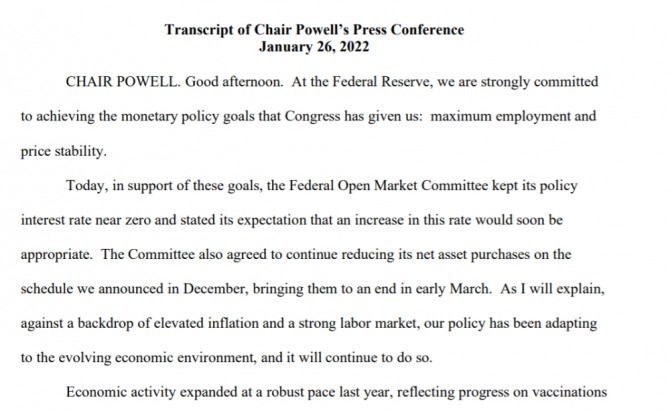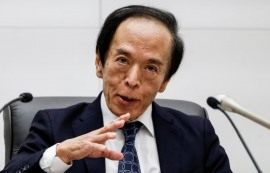제롬파월 연준 FOMC 의장 기자회견 전문 해설
 이미지 확대보기
이미지 확대보기제롬 파월은 FOMC 직후 기자회견에서 초 강걍 긴축 예고 발언을 쏟아냈다. 뉴욕증시가 특히 충격을 받은 대목은 "금리인상 겸손하고 민첩할"(humble and nimble) 필요"
"고용과 물가의 놀랄 만한 진전을 고려할 때 더는 통화 정책적 지원이 필요하지 않다” "연준 대차대조표가 필요한 것보다 훨씬 크다, 더 빠르게 축소가 가능하다” 그리고 "노동시장을 위협하지 않고도 금리를 인상할 수 있는 여지가 꽤 많다”등이다,
그 중에서도 뉴욕증시가 특히 충격을 받은 대목은 'humble & nimble이다. 대담하고 민첩하게 금리인상을 단행하겠다는 제롬파월의 이 말이 뉴욕증시와 비트코인등 가상화폐 폭락의 단초가 됐다. 일부 국내 언론은 'humble & nimble을 겸손하고 민첩한 금리인상이라고 번역했으나 미국 현지에서는 대담하고 민첩한으로 해석하고 있다. 좌고우면하지 않고 금리를 대폭 올리면서 긴축의 강도를 높이겠다는 것이다.
미국 연준은 연방공개시장위원회(FOMC) 정례회의를 마친 뒤 낸 정책결정문에서 “2%를 훨씬 상회하는 인플레이션(물가오름세)과 강력한 노동시장으로 인해 FOMC는 곧 연방기금 금리의 목표 범위를 높이는 것이 적절할 것으로 기대한다”고 밝혔다. 이번 달에는 금리를 동결했지만 사실상 3월에는 금리를 올리겠다는 점을 분명히 한 것이다. 또 현재 진행 중인 자산매입 축소 즉 테이퍼링은 기존 방침을 유지키로 했다.
파월 의장의 발언들은 예상을 넘어선 ‘매파적(긴축 선호)’ 신호를 보낸 것으로 시장은 받아들였다. 그는 올해 남은 회의 때마다 금리를 올릴 가능성이 있느냐는 질문에 즉답하지 않고 “겸손하고 민첩할” 필요가 있다며 “향후 데이터와 전망 변화에 따라 대응할 것”이라고 말했다. 여기에 대해 뉴욕증시는 파월이 3월 이후 6차례 회의에서 모두 금리를 인상할 가능성을 배제하지 않은 것이라고 해석했다. 이는 그동안 대세를 이뤘던 연간 4회 인상 전망을 훌쩍 넘넜다. 경우에 따라 6~7차례의 금리 인상이 가능하다는 뜻으로 받아들여졌다, 한번의 인상폭이 0.5%포인트가 될 가능성도 열어뒀다.
한국시간 28일 아침에 마감한 뉴욕증시는 제롬파월 발언 후폭풍으로 또 하락했다. 뉴욕 증권거래소(NYSE)에서 다우존스30산업평균지수는 7.31포인트(0.02%) 하락한 34,160.78로 마쳤다. 스탠더드앤드푸어스(S&P)500지수는 23.42포인트(0.54%) 떨어진 4,326.51에 , 또 기술주 중심의 나스닥 지수는 전장보다 189.34포인트(1.40%) 밀린 13,352.78로 거래를 마감했다. 매파적 즉 통화긴축적이었던 연준 FOMC 회의 결과와 4분기 GDP 과열 우려가 뉴욕증시 발목을 잡았다. 비트코인 이더리움 도지코인 리플등 암호화폐도 파월의 말에 위축됐다.
상무부가 발표한 지난해 4분기(10~12월) 미국의 국내총생산(GDP) 성장률은 신종 코로나바이러스 감염증(코로나19) 오미크론 확산에도 연율 6.9%를 기록했다,. 예상치 5.5% 증가를 크게 웃돌았다. 지난 3분기 GDP 성장률 2.3%에서 크게 반등한 것이다. 주간 실업보험 청구자 수는 계절 조정 기준으로 전주보다 3만 명 감소한 26만 명을 기록했다. 미국 시카고상품거래소(CME) 페드워치에 따르면 연방기금(FF) 금리 선물 시장은 올해 3월 연준이 금리를 인상할 가능성을 100%로 내다봤다. 1회 인상 가능성은 83.8%, 2회 인상 가능성도 16.3%에 달했다. 5월 연준이 두 번째 금리 인상에 나설 가능성도 80%에 육박했으며, 해당 회의에서 1회 인상 가능성은 65.6%로 절반을 넘어섰다. 2회 인상 가능성도 11.9%에 달한다. 올해12월 회의까지 연준이 5회 이상 금리를 인상할 가능성도 60%를 넘어섰다. 이는 한 달 전에 10% 수준에 불과했다. 미국 시카고옵션거래소(CBOE) 변동성 지수(VIX)는 전장보다 1.47포인트(4.60%) 하락한 30.49를 기록했다.
Transcript of Chair Powell’s Press Conference
CHAIR POWELL. Good afternoon. At the Federal Reserve, we are strongly committed
to achieving the monetary policy goals that Congress has given us: maximum employment and
price stability.
Today, in support of these goals, the Federal Open Market Committee kept its policy
interest rate near zero and stated its expectation that an increase in this rate would soon be
appropriate. The Committee also agreed to continue reducing its net asset purchases on the
schedule we announced in December, bringing them to an end in early March. As I will explain,
against a backdrop of elevated inflation and a strong labor market, our policy has been adapting
to the evolving economic environment, and it will continue to do so.
Economic activity expanded at a robust pace last year, reflecting progress on vaccinations
and the reopening of the economy, fiscal and monetary policy support, and the healthy financial
positions of households and businesses. Indeed, the economy has shown great strength and
resilience in the face of the ongoing pandemic. The recent sharp rise in COVID cases associated
with the Omicron variant will surely weigh on economic growth this quarter. High-frequency
indicators point to reduced spending in COVID-sensitive sectors, such as travel and restaurants.
And activity more broadly may also be affected as many workers are unable to report for work
because of illness, quarantines, or caregiving needs. Fortunately, health experts are finding that
the Omicron variant has not been as virulent as previous strains of the virus, and they expect that
cases will drop off rapidly. If the wave passes quickly, the economic effects should as well, and
we would see a return to strong growth. That said, the implications for the economy remain
uncertain. And we have not lost sight of the fact that for many afflicted individuals and families,
and for the healthcare workers on the front lines, the virus continues to cause great hardship.
January 26, 2022 Chair Powell’s Press Conference PRELIMINARY
Page 2 of 26
The labor market has made remarkable progress and by many measures is very strong.
Job gains have been solid in recent months, averaging 365,000 per month over the past three
months. Over the past year, payroll employment has risen by 6.4 million jobs. The
unemployment rate has declined sharply, falling 2 percentage points over the past six months to
reach 3.9 percent in December. The improvements in labor market conditions have been
widespread, including for workers at the lower end of the wage distribution, as well as for
African Americans and Hispanics. Labor demand remains historically strong. With constraints
on labor supply, employers are having difficulties filling job openings and wages are rising at
their fastest pace in many years. While labor force participation has edged up, it remains
subdued, in part reflecting the aging of the population and retirements. In addition, some who
would otherwise would be seeking work report that they are out of the labor force because of
factors related to the pandemic, including caregiving needs and ongoing concerns about the
virus. The current wave of the virus may well prolong these effects. Over time there are good
reasons to expect some further improvements in participation and employment.
Inflation remains well above our longer-run goal of 2 percent. Supply and demand
imbalances related to the pandemic and the reopening of the economy have continued to
contribute to elevated levels of inflation. In particular, bottlenecks and supply constraints are
limiting how quickly production can respond to higher demand in the near term. These problems
have been larger and longer lasting than anticipated, exacerbated by waves of the virus.
While the drivers of higher inflation have been predominantly connected to the
dislocations caused by the pandemic, price increases have now spread to a broader range of
goods and services. Wages have also risen briskly, and we are attentive to the risks that
January 26, 2022 Chair Powell’s Press Conference PRELIMINARY
Page 3 of 26
persistent real wage growth in excess of productivity could put upward pressure on inflation.
Like most forecasters, we continue to expect inflation to decline over the course of the year.
We understand that high inflation imposes significant hardship, especially on those least
able to meet the higher costs of essentials like food, housing, and transportation. In addition, we
believe that the best thing we can do to support continued labor market gains is to promote a long
expansion, and that will require price stability. We are committed to our price stability goal. We
will use our tools both to support the economy and a strong labor market and to prevent higher
inflation from becoming entrenched. And we will be watching carefully to see whether the
economy is evolving in line with expectations.
The Fed’s monetary policy actions have been guided by our mandate to promote
maximum employment and stable prices for the American people. As I noted, the Committee
left the target range for the federal funds rate unchanged and reaffirmed our plan, announced in
December, to end asset purchases in early March. In light of the remarkable progress we have
seen in the labor market and inflation that is well above our 2 percent longer-run goal, the
economy no longer needs sustained high levels of monetary policy support. That is why we are
phasing out our asset purchases and why we expect it will soon be appropriate to raise the target
range for the federal funds rate.
Of course, the economic outlook remains highly uncertain. Making appropriate monetary
policy in this environment requires humility, recognizing that the economy evolves in
unexpected ways. We will need to be nimble so that we can respond to the full range of
plausible outcomes. With this in mind, we will remain attentive to risks, including the risk that
high inflation is more persistent than expected, and are prepared to respond as appropriate to
achieve our goals.
January 26, 2022 Chair Powell’s Press Conference PRELIMINARY
Page 4 of 26
To provide greater clarity about our approach for reducing the size of the Federal
Reserve’s balance sheet, today the Committee issued a set of principles that will provide a
foundation for our future decisions. These high-level principles clarify that the federal funds rate
is our primary means of adjusting monetary policy and that reducing our balance sheet will occur
after the process of raising interest rates has begun. Reductions will occur over time in a
predictable manner primarily through adjustments to reinvestments so that securities roll off our
balance sheet. Over time, we intend to hold securities in the amounts needed for our ample
reserves operating framework, and in the longer run we envision holding primarily Treasury
securities. Our decisions to reduce our balance sheet will be guided by our maximum
employment and price stability goals. In that regard, we will be prepared to adjust any of the
details of our approach to balance sheet management in light of economic and financial
developments. The Committee has not made decisions regarding the specific timing, pace, or
other details of shrinking the balance sheet, and we will discuss these matters in upcoming
meetings and provide additional information at the appropriate time.
To conclude, we understand that our actions affect communities, families, and businesses
across the country. Everything we do is in service to our public mission. We at the Federal
Reserve will do everything we can to achieve our maximum employment and price stability
goals. Thank you. I look forward to your questions.
MICHELLE SMITH. Thank you. For the first question, we'll go to Chris Rugaber,
Associated Press.
CHRIS RUGABER. Thanks, Michelle. And thank you, Chair Powell. So it's expected
that the Fed will hike rates perhaps every other meeting. But certainly in the past, the Fed has
hiked at every meeting. So I just wanted to ask, you know, are rate hikes at consecutive meetings
January 26, 2022 Chair Powell’s Press Conference PRELIMINARY
Page 5 of 26
on the table this year? Is every meeting a live meeting? And, on that note, would the Fed
consider frontloading some of its rate hikes, even if it doesn't raise every meeting? Thank you.
CHAIR POWELL. Thanks. So, as I referred to in my opening statement, it's -- it is not
possible to predict with much confidence exactly what path for our policy rate is going to prove
appropriate. And so, at this time, we haven't made any decisions about the path of policy. And I
stress again that we'll be humble and nimble. We're going to have to navigate cross-currents and
actually two-sided risks now. So -- and I'll say also that we're going to be guided by the data. In
fact, what I'll say is that we're going to be led by the incoming data and the evolving outlook,
which we'll try to communicate as clearly as possible, moving steadily in transparency --
transparently. So more to your question. We know that the economy is in a very different place
than it was when we began raising rates in 2015. Specifically, the economy is now much
stronger. The labor market is far stronger. Inflation is running well above our 2 percent target,
much higher than it was at that time. And these differences are likely to have important
implications for the appropriate pace of policy adjustments. Beyond that, we haven't made any
decisions.
MICHELLE SMITH. Thank you. Let's go to Victoria Guida at Politico.
VICTORIA GUIDA. Hi, Chair Powell. I wanted to ask, you were talking about the
health of the labor market. And I'm curious whether you would characterize where we're at right
now as maximum employment? And also, along those same lines, obviously, rate hikes on the
table this year, do you think that the Fed can raise rates, bring inflation under control without
hurting jobs and wages?
January 26, 2022 Chair Powell’s Press Conference PRELIMINARY
Page 6 of 26
CHAIR POWELL. Sorry. Just getting both parts of your question written down. So, I
would say -- and this view is widely held on the Committee -- that both sides of the mandate are
calling for us to move steadily away from the very highly accommodative policies we put in
place during the challenging economic conditions that the economy faced earlier in the
pandemic. And I would say that most FOMC participants agree that labor market conditions are
consistent with maximum employment in the sense of the highest level of employment that is
consistent with price stability. And that is my personal view. And, again, very broad support on
the Committee for the judgement that it will soon be appropriate to raise the target range for the
federal funds rate. The other thing is maximum employment will evolve over time and through
the course of a business cycle. In the particular situation we're in now, it may well increase max -
- the level of maximum employment that's consistent with stable prices may increase. And we
hope that it will as more people come back into the labor market, as participation gradually rises.
And the policy path that we're broadly contemplating would be supportive of that comment --
that outcome as well. So, the thing about the labor market right now is that there are -- there are
many millions of more job openings than there are unemployed people. So you ask whether we
can -- whether we can raise rates and move to a less accommodative and even tight financial
conditions without hurting the labor market. I think there's quite a bit of room to raise interest
rates without threatening the labor market. This is, by so many measures, a historically tight
labor market, record levels of job openings, of quits. Wages are moving up at the highest pace
they have in decades. If you look at surveys of workers, they find jobs plentiful. Look at surveys
of companies, they find workers scarce. And all of those readings are at levels really that we
haven't seen in a long time and, in some cases, ever. So, this is a very, very strong labor market.
And my strong sense is that we can move rates up without having to, you know, severely
January 26, 2022 Chair Powell’s Press Conference PRELIMINARY
Page 7 of 26
undermine it. I also would point out that there are other forces at work this year, which should
also help bring down inflation. We hope including improvement on the supply side, which will
ultimately come at the timing and pace of that are uncertain. And also, fiscal policy is going to be
less supportive of growth this year, not at the level of economic activity but the fiscal impulse to
growth will be significantly lower. So there are multiple forces which should be working over
the course of the year for inflation to come down. We do realize that the timing and pace of that
are highly uncertain and that inflation has persisted longer than we thought. And, of course,
we're prepared to use our tools to assure that higher inflation does not become entrenched.
MICHELLE SMITH. Thank you. Let's go to Nick Timiraos at the Wall Street Journal.
NICK TIMIRAOS. Good afternoon, Chair Powell. Nick Timiraos of The Wall Street
Journal. I have a couple of questions on the balance sheet. The statement on the balance sheet
today calls for significantly reducing your holdings. What does that mean? And then, apart from
moving sooner and faster to shrink the holdings, are there any other ways in which you and your
colleagues are seriously thinking about recalibrating this process? And, finally, how much
disagreement is there around how you should use this tool, including active sales rather than
passive sales or changes in the composition of reinvestments? Thank you.
CHAIR POWELL. So I'm afraid to tell you that those are all great questions, and they're
questions that the Committee is just turning to now. So we had a discussion, as you know, at the
last meeting, an introductory discussion of the balance sheet and teeing up of the issues. At this
meeting, we've gone through and carefully put together a set of principles at a high-level. And
those are meant to guide the actual decisions we'll make about the pace and about all of the
questions that you're asking. And I expect that this process will be something that we spent time
on in coming meetings. I can't tell you how many; I can't say how long it will take. But -- and
January 26, 2022 Chair Powell’s Press Conference PRELIMINARY
Page 8 of 26
then, you know, at the appropriate time, we'll provide additional information. So, I did -- the last
cycle when we went through balance sheet issues, we did find that over the course of two or
three meetings, for example, we did come to interesting and better answers, we thought. So we're
just in that process now. And at the next meeting, we'll be turning to, you know, more of the
details that you're asking about. I would say this. The balance sheet is much bigger. I'd say it has
a shorter duration than the last time. And the economy's much stronger, and inflation is much
higher. So -- and I think that leads you to -- and I said -- I've said this, being willing to move
sooner than we did the last time and also perhaps faster. But, beyond that, it's really not
appropriate for me to speculate exactly what that would be. And -- but I would point you to
principle number one, which is the Committee views changes in the target rate for the federal
funds rate as its primary means of adjusting the stance of monetary policy. So, we do want the
federal funds rate, we want to operationalize that. And we want the balance sheet to be declining
in a predictable manner, and we want it to be declining primarily by adjusting reinvestments.
NICK TIMIRAOS. So, if I could follow on that, raising rates and reducing the balance
sheet both restrain the economy, both tighten monetary policy. How should we think about the
relationship between the two? For example, how much passive runoff is equal to every quarter
percentage point increase in your benchmark rate?
CHAIR POWELL. So, again, we think of the balance sheet as moving in a predictable
manner, sort of in the background, and that the active tool meeting to meeting is not -- both of
them, it's the federal funds rate. There are rules of thumbs. I'm reluctant to land on one of them
that equate this. And there's also an element of uncertainty around the balance sheet. I think we
have a much better sense, frankly, of how rate increases affect financial conditions and, hence,
economic conditions. Balance sheet is still a relatively new thing for the markets and for us, so
January 26, 2022 Chair Powell’s Press Conference PRELIMINARY
Page 9 of 26
we're less certain about that. So, again, our -- I think our -- the pattern we'll follow is to arrive at
a, you know, a timing and a pace and composition and all those things and then announce that
with advance notice, and it will start in the background. And then we will look to have that just
running in the background and have the interest rates, again, be the active tool of monetary
policy. That's at least the plan. I can't tell you much more about any of the very good issues about
size, pace, composition, those sorts of things. But we'll be turning to all of those at coming
meetings.
NICK TIMIRAOS. Thank you.
MICHELLE SMITH. Thanks. Now we'll go to Neil Irwin.
NEIL IRWIN. Thank you, Chair Powell. It's Neil Irwin from Axios. Glad to be back. Sir,
I was wondering if the volatility we've seen in the financial markets in the last few weeks strikes
you as anything alarming or that might affect the trajectory of policy. Conversely, to the degree
that financial conditions have tightened some, might that be desirable in some ways in achieving
your tightening goals?
CHAIR POWELL. So, as you know, the ultimate focus that we have is on the real
economy, maximum employment, and price stability. And financial conditions matter to the
extent that they have implications for achieving the dual mandate. And you also know that we
look at broader financial conditions, not one or two things, one or two markets. And what we're
always asking ourselves is, are we seeing changes that are both persistent and material enough
that -- of a change in financial conditions that they are inconsistent with the achievement of our
goals? So that's how we're looking at that. And I don't want to comment on today's financial
conditions broadly, but we're not looking at any one market or so. So that's how we're thinking.
January 26, 2022 Chair Powell’s Press Conference PRELIMINARY
Page 10 of 26
In terms of what we've seen, I would say this. We -- you know, we said at our last meeting we
published the summary of economic projections, the meaning of which the median participant
expected three rate increases this year. And, you know, it's six weeks, seven weeks later now.
And you have seen that our communication channel with the markets is working. Markets are
now pricing in a number of rate increases. Surveys show that market participants are expecting a
balance sheet runoff to begin, you know, at the appropriate time sometime later this year
perhaps. We haven't made that decision yet. So, we feel like the communications we have with
market participants and with the general public are working and that financial conditions are
reflecting in advance the decisions that we make. And monetary policy works significantly
through expectations. So that in and of itself is appropriate.
MICHELLE SMITH. Thank you. Let's go to Howard Schneider.
HOWARD SCHNEIDER. You know, for a year or so -- Hi. Thanks, Chair Powell.
Howard Schneider with Reuters. So for a year now, the statements referenced the benchmarks
for this initial interest rate increase. Now that we're approaching that moment, what are the
benchmarks going to be for subsequent rate increases? I know you can't stipulate the path, but
how should we think about the criteria for the next step and the next step?
CHAIR POWELL. Well, you're right. We haven't got -- we haven't gotten to that point.
We haven't made a decision yet, and we'll make that decision at the March meeting. We'll make a
decision whether to raise the federal funds rate. I would say that the Committee is of a mind to
raise the federal funds rate at the March meeting, assuming that conditions are appropriate for
doing so. We have our eyes on the risks, particularly around the world. But we do expect some
softening in the economy from Omicron, but we think that should be temporary. And we think
January 26, 2022 Chair Powell’s Press Conference PRELIMINARY
Page 11 of 26
that economy should -- the underlying strength of the economy should, you know, should show
through fairly quickly after that.
HOWARD SCHNEIDER. If I could follow just on a related question, the December
SEPs had this copacetic sort of set of circumstances where inflation comes down without the
federal funds rate ever getting over the estimate of neutral. Given developments since then, do
you still think that's a credible narrative for the ultimate path of policy?
CHAIR POWELL. I think the path is highly uncertain in that we're committed to using
our tools to make sure that inflation, high inflation that we're seeing does not become entrenched.
So, a number of factors would be -- it's not just monetary policy. A number of factors are
supporting a decline in inflation, as I mentioned. Fiscal policy will be -- will providing
significantly less of an impulse to growth. We do expect this year, although we do expect now
that it will come slower than we had expected and hoped, that there will be relief on the supply
side. So that, too, should lower the supply side barriers, which are a big part of the story of why
inflation. It's like, in addition, monetary policy will be becoming significantly less
accommodative. So the question is, you know, we'll be asking this question all year long, and
that will be our things turning out as we expect? There's a case that, for whatever reason, the
economy slows more and inflation slows more than expected, we'll react to that. If, instead, we
see inflation at a higher level or a more persistent level, then we'll react to that. And, again, we're
well aware that this is a different economy than existed during the last tightening cycle, and our
policy is going to reflect those differences.
HOWARD SCHNEIDER. Thank you.
January 26, 2022 Chair Powell’s Press Conference PRELIMINARY
Page 12 of 26
MICHELLE SMITH. Thank you. Thank you. Let's go to Jeanna Smialek. Let's go to
Jeanna. Okay. Let's go to Steve Liesman.
STEVE LIESMAN. Thank you, Michelle. And thank you, Mr. Chairman. Mr. Chairman,
I have one sort of technical question and one question on principle. The technical question is, if
you're going to discuss balance sheet at the next upcoming meetings and you won't begin balance
sheet reduction until after you begin rate hikes, it seems to technically mean that you won't or
can't begin balance sheet reduction until the summer; is that correct? That's the first thing.
Second of all, you suggested that the -- with the balance sheet running in the background, that
you would possibly be raising rates and running off the balance sheet at the same time. That's
sort of a technical question part of it. The principle question I have is you said it's going to be
running in the background. But the statement on the balance sheet principle says the Committee
is prepared to adjust any of the details of its approach based on economic and financial
developments, which suggests there's something of a reaction function associated to the balance
sheet and it won't be running in the background. So can you give us any sense of the discussion
or staff presentation on what is the reaction function surrounding the balance sheet? Thanks.
CHAIR POWELL. So let me start by talking about that last paragraph. So you'll
remember during the last cycle that this process of building up and then shrinking the balance
sheet is a complicated one, and it involves inevitably surprises. And so during the years there in
the prior cycle, we amended our balance sheet principles a number of times. Now, we didn't
intend to do that. It just -- events required us to do so. So we got a pretty robust paragraph there
that says we're free to do this at any time. And it doesn't mean we're going to. But if the situation
turns out to be different than we had thought, we're not going to be -- we're not going to stick
with something that isn't working. That's all that's saying. It's meant to be quite a general
January 26, 2022 Chair Powell’s Press Conference PRELIMINARY
Page 13 of 26
statement rather than a hint. So, I mean, I like to think that our -- you know, our philosophy of
the balance sheet is embodied in these principles. So, you know, the idea that, for example, the
federal funds rate is the primary means of adjusting the stance of policy that we'll use, determine
the timing and pace of reducing the size of the balance sheet to foster the dual mandate that will
begin to reduce the size after we begin the process of raising rates and on and on like that. I
mean, that -- those are all the things that try to describe how we will proceed. But maybe at a
higher level, to try to get at your question, you know, asset purchases were enormously important
at the beginning of the recovery in terms of restoring market function as they were at -- right
after the -- in the critical phase of the global financial crisis. And then, after, they were a
macroeconomic tool to support demand. And now the economy no longer needs this highly
accommodative policy that we put in place. So it's time to stop asset purchases first and then, at
the appropriate time, start to shrink the balance sheet. Now, the balance sheet is substantially
larger than it needs to be. We've identified the end state as -- in amounts needed to implement
monetary policy efficiently, effectively in the ample reserve regime. So there's a substantial
amount of shrinkage in the balance sheet to be done. That's going to take some time. We want
that process to be orderly and predictable. And so those are some of the ways I would think this
lays out our -- you know, the way we -- the way we're thinking about this. In terms of the timing,
I can't really help you. You know, it just says after we get underway. So we're -- I would say we
are -- we're going to have another discussion at the next meeting. And my guess is we'll have at
least one other discussion at the meeting after that. And, you know, we'll tell you as we make
progress. And we'll -- you know, we'll start the process of allowing runoff and shrinking the
balance sheet at what we find to be the appropriate time. It's -- I wish I could say more. But,
January 26, 2022 Chair Powell’s Press Conference PRELIMINARY
Page 14 of 26
honestly, we haven't made those decisions. And we actually haven't even really had the
important discussions on a lot of the details that we will have at coming meetings.
MICHELLE SMITH. Thank you. Let's go to Craig Torres.
CRAIG TORRES. Chair Powell, Chair Powell. Good afternoon, Michelle and Chair
Powell. Craig Torres from Bloomberg. Chair Powell, at the beginning of the conversation, you
said risks are two sided. And I'm wondering if you can elaborate on what are the risks to the
elusive soft landing? Is Fed policy a risk? Over-tightening? Or what are the risks? And then
second, Chair Powell, I have a quick administrative question. You know, Robert Kaplan's
disclosure of his securities transactions, in a couple of months, Chair Powell, or maybe sooner,
you and I will file our tax returns. And we'll list transactions and all kinds of things. And next to
those transactions we'll put dates. And Bloomberg asked for the dates of Mr. Kaplan's
transactions. The Dallas Fed is not giving us the dates. And I don't see why this is a matter for
the Inspector General or anybody else. I mean, why can't he give us the dates? Will you help us
get the dates of those transactions? Thanks.
CHAIR POWELL. So you asked about the risks first. So I -- you know, the one risk is
that inflation risks are still to the upside in the views of most FOMC participants and certainly in
my view, as well. There's a risk that the high inflation we're seeing will be prolonged, and there's
a risk that it will move even higher. So, we don't think that's the base case, but you asked what
the risks are. And that's -- we have to be in a position with our monetary policy to address all of
the plausible outcomes. And that calls for us to be in position. We have an expectation about the
way the economy is going to be evolved, but we've got to be in a position to address different
outcomes, including the one where inflation remains higher. And, of course, that is a risk to the
expansion. You know, we've been saying that what we need here is another long expansion,
January 26, 2022 Chair Powell’s Press Conference PRELIMINARY
Page 15 of 26
which is the kind of thing we saw over the last -- which is a record long expansion. We saw labor
force participation rise. We saw wages persistently higher for people at the lower end, and there
were -- there really was no obvious imbalance in the economy that threatened that expansion. It
could have gone on for years were it not hit by the pandemic. So, we'd love to find a way to get
back to that. That's going to require price stability, and that's going to require the Fed to tighten
interest rate policy and do our part in getting inflation back down to our 2 percent goal. So I
mentioned two-sided risks. You know, a couple things. One, COVID is not over. And COVID
can continue to evolve, and it's just -- we have to accept that it's not over, and the risks to it can
slow down growth. And that would be -- that's sort of a downside risk from a growth standpoint.
I would point to, you know, another risk is just further problems in the supply chains, which
could slow down activity. And you see the situation in China has a situation there where that's
their no COVID policy may cause more lockdowns. It is likely to, and that may play into -- may
play into more problems in supply chains. In addition, there's what's going on in Eastern Europe
and things like that. So there's plenty of risk out there. And we, you know, we can't forget that
there are risks on both sides. So that's there. That's what I would say. I know you've been all over
this issue with my colleagues, Craig, on the issue of information. We don't have that information
at the Board. And, you know, I hand -- I asked the Inspector General to do an investigation, and
that is out of my hands. I'm playing no role in it. I seek to play no role in it. And I don't -- I really
-- I can't help you here today on this issue. And I'm sorry I can't.
CRAIG TORRES. Okay, okay.
MICHELLE SMITH. We'll go to Jeanna now.
JEANNA SMIALEK. Thanks for taking our questions, Chair Powell. And sorry for my
tech issues. I wonder if you could tell us a little bit about where your thinking on inflation stands
January 26, 2022 Chair Powell’s Press Conference PRELIMINARY
Page 16 of 26
today. You know, the last time we saw an SEP back in September, we saw that you and your
colleagues were projecting that inflation would sort of sink back down quite close to target by
the end of the year. And I wonder if you still think that projection from December is a reasonable
one. And if your thinking has changed at all, I wonder how you're thinking about that. And I also
wonder if you could talk a little bit about the pathway to getting to that deceleration? Like, how
do we get from here, 7 percent CPI to where you expect to be at the end of the year.
CHAIR POWELL. So I'd say, you know, since the December meeting, I would say that
the inflation situation is about the same but probably slightly worse. I'd be inclined to raise my
own estimate of 2022 core PCE inflation, let's just go with that, by a few tenths today. But we're
not writing down an SEP at this meeting, but I think it's -- it hasn't gotten better. It's probably
gotten just a bit worse, and that's been the pattern. That's been the pattern. So I think if you look
at the FOMC participants are -- there's a range there. And that range has been moving to the right
for a year now. And, by the way, if you look at other forecasters, essentially all other macro
forecasters who do this for a living you've seen the same pattern. So what do we think about
that? Well, I think we -- you know, we wrote down rate increases in the December meetings,
each of us individually. And I think to the extent the situation deteriorates further, our policy will
have to address that, if it deteriorates meaningfully further, either in the time dimension or in the
size of the inflation dimension. So that's how we're thinking about it. I -- as I mentioned, though,
I think it's part of this will be that us, the Fed moving away from a very highly accommodative
policy to a substantially less accommodative policy and then, over time, to a policy that's not
accommodative in time. I don't know when that will be. That's -- those are the things that we're
thinking about. That's part of it. Another part of it is that fiscal policy provided an impulse to
growth over the last two years. That impulse will be less, in fact, will be negative this year. And
January 26, 2022 Chair Powell’s Press Conference PRELIMINARY
Page 17 of 26
so that's another thing. The other one is we will eventually get relief on the supply side. And, you
know, the ports will be cleared up. And there will be semiconductors and things like that. Now,
what we're learning is it's just taking much longer. So I think -- longer than expected. And that I
think does raise the risk, that high inflation will be more persistent. I do think we'll come off of
the highs that we saw in the early part of this episode in the spring last year. But really, what's --
the question is going to be what is inflation running at? And so we'll be watching that. And I --
you know, we, our objective is to get inflation back down to 2 percent. It's also to provide
enough support to keep the labor market healthy. The labor market is very, very strong right
now, and I think that strength will continue. There's a -- there's really a shortage of workers. We
see it, particularly among production and nonsupervisory workers and people in the lowest
quartile. You see very large wage increases. I mentioned some of the other indicators. So I think
that's what we're looking at. And we're also -- you know, we realize, I think, as everyone does
that this outlook is quite uncertain and that we're going to have to adapt. And we're going to
communicate as clearly as we can. But we're going to have to be adaptable, and you know, move
as appropriate.
JEANNA SMIALEK. Great. Thank you.
MICHELLE SMITH. Thank you. Let's go to Colby Smith.
COLBY SMITH. Thank you, Michelle. Chair Powell, when you talk about being humble
and nimble about the path forward for monetary policy. Does that also include the possibility of
raising interest rates by larger increments and, say, doing a 50 basis points hike at some point, if
inflation does not moderate sufficiently? And should we interpret this approach as a departure
from the gradual pace that we saw during the last hiking cycle?
January 26, 2022 Chair Powell’s Press Conference PRELIMINARY
Page 18 of 26
CHAIR POWELL. So, as I mentioned, we have not made these decisions. We really
haven't. And what I can tell you now, though, is that we fully appreciate that this is a different
situation. If you look back to where we were in 2015 '16, '17, '18 when we were raising rates,
inflation was very close to 2 percent, even below 2 percent. Unemployment was not at our
estimates of natural rate. And growth was, you know, in the 2 to 3 percent range. Right now we
have inflation running substantially above 2 percent and, you know, more persistently than we
would like. We have growth -- even in forecasts, even in the somewhat reduced forecast for
2022, we still see growth higher than, substantially higher than what we estimate to be the
potential growth rate. And we see a labor market where, by so many measures, it is historically
tight. I think the -- you know, in a way, the least tight aspect of it is looking at the unemployment
rate, which is still below our median estimate of maximum employment. If you look at things
like quits and job openings, as I mentioned earlier, and wages, you're seeing -- and just the ratio
of job openings to unemployed, you're seeing a very, very tight labor market. Now, we also
know that labor force participation is significantly lower. It's a percentage point and a half lower
than it was in February of 2020. Maybe a percentage point of that is retirements. Some part of
those retirements are, you know, related to COVID rather than just regular retirement. So we
think there's -- there is a pool of people out there who could come back into the labor force. But
it's not happening very quickly, and it may not -- it may continue to not happen very quickly, as
long as the pandemic is on. So, that's -- that's how we think about that. We haven't made -- to
your specific question, we really have not addressed those questions. And we'll begin to address
them as we move into the March meeting and meetings after that.
MICHELLE SMITH. Let's go to Rachel.
January 26, 2022 Chair Powell’s Press Conference PRELIMINARY
Page 19 of 26
RACHEL SIEGEL. Thank you, Michelle. And thank you, Chair Powell, for taking our
questions. I'm wondering if you can talk to us about any metrics that the Fed uses to assess how
inflation affects different groups of Americans, especially lower-income earners? And are you
worried that the Fed underestimates or can't effectively measure the impact of inflation on some
of the most vulnerable households? Thank you.
CHAIR POWELL. So it's more a matter of -- I think the problem that we're talking about
here is really that people are on fixed incomes who are living paycheck to paycheck, they're
spending most or all of their -- of what they're earning on food, gasoline, rent, heating their --
heating, things like that, basic necessities. And so inflation right away, right away forces people
like that to make very difficult decisions. So that's really the point. I don't -- I'm not aware of,
you know, inflation literally falling more on different socioeconomic groups. It's -- that's not the
point. The point is some people are just really in -- prone to suffer more. I mean, for people who
are economically well off, inflation isn't good. It's bad. High inflation is bad, but they're going to
be able to continue to eat and keep their homes and drive their cars and things like that. It's more
-- so that that's really how I think of it. And, you know, we have to control inflation for the
benefit of all Americans. But part of the -- part of it is just that it's particularly hard on people
with fixed incomes and low incomes who spent most of their income on necessities, which are
experiencing high inflation now.
MICHELLE SMITH. Thank you. Let's go to Edward Lawrence.
EDWARD LAWRENCE. Thanks, Michelle. Thank you, Mr. Chairman, for taking the
question here. So year over year, inflation's at a 40-year high. The input costs for producer price
index for all of 2021 was the highest on record. Some investors fear that the Fed might be
moving too late. Now, you said no decisions were made on the path of rate hikes, but was a rate
January 26, 2022 Chair Powell’s Press Conference PRELIMINARY
Page 20 of 26
hike more than 25 basis points discussed today? And as a follow to that because I had problems
with the mute button, as a follow to that, you testified that the supply chain issues could be
worked out by the end of the year. You talked about that today. The CEO of Ford, though, told
Fox Business today that the chip shortage will last into 2023. So today you said inflation will
start to ease this year. I want to drill down and get a timeline that you see as to when we could
see that relief. Thank you.
CHAIR POWELL. So I would not say that I would expect the supply chain issues to be
completely worked out by the end of this year. I do not expect them and I have not expected
them. What I would say and I have been saying is that I expect progress to be made in the second
half of this year, mainly, progress because we're not making much progress. If you look at a ton
of metrics, you can find some that suggest that delivery times are shorter and inventories in some
industries' moving up. But, overall, we're not -- we're not making progress. And, you know,
things like the semiconductor issue, we're going to -- they're going to be quite a long time. We
think they'll go more than through 2023. In terms of -- so in terms of being too late, I would just
say this. We -- our policy needs to be positioned to address the full range of plausible outcomes,
as I said, and particularly the possibility that inflation will continue to run higher, more
persistently than we'd expected. And we think we are positioned to make the changes in our
policy to do that, and we're committed to doing that. And that -- that's really where we are. In
terms of your question about the size of rate increases, we haven't faced those decisions. We
haven't made them. It isn't possible to sit down here today and tell you with any confidence what
the precise path will be. But in -- as we work our way through this meeting by meeting, we are
aware that this is a very different expansion, as I've said a couple times, with higher inflation,
January 26, 2022 Chair Powell’s Press Conference PRELIMINARY
Page 21 of 26
higher growth, a much stronger economy. And I think those differences are likely to be reflected
in the policy that we implement.
MICHELLE SMITH. Thank you. Let's go to Mike McKee.
MICHAEL MCKEE. Thank you, Mr. Chairman. I'd like to sort of weave some of the
strands of your answers together and ask you, as you start to reverse policy, what your goal is.
Are you going to be raising interest rates until you get inflation to 2 percent? Do you want to go
below 2 percent so that, on average, you get a 2 percent inflation rate? And because you said we
have to protect the employment part of your mandate, is there some sort of circuit breaker that
would stop you from raising interest rates on the employment side?
CHAIR POWELL. So, no. There's no -- there's nothing in our framework about having
inflation run below 2 percent so that we would do that, try to achieve that outcome. So the
answer to that is no. What we're trying to do is get inflation, keep inflation expectations well
anchored at 2 percent. That's always the ultimate goal. And we do that in the service of having
inflation -- we get to that goal by having inflation average 2 percent over time. And if inflation
doesn't average 2 percent over time, then it's not clear why inflation expectations would be
anchored at 2 percent. So that -- that's the way we think about that. You know, it -- what was the
last part of your question?
MICHAEL MCKEE. I was asking if you're protecting the employment side of the
mandate, whether there's some sort of circuit breaker there.
CHAIR POWELL. Nothing like that. I mean, I would say you have a tremendously
strong labor market. And you have growth this year at -- forecast to be well above, well above
potential. I mean, people are forecasting growth. You think potential growth is around 2. Most
January 26, 2022 Chair Powell’s Press Conference PRELIMINARY
Page 22 of 26
forecasts are significantly above that for 2022, and that's even with policy becoming
substantially less accommodative. So the labor market's going to be strong for some time. We --
ideally what we're trying to achieve is inflation getting back down to 2 percent. And we're trying
to do that in a process that accomplishes -- you know, that will also leave the labor market in a
very strong position. And no one really knows what that will take. Again, I would say that it isn't
just monetary policy that's helping inflation get down. It'll be supply side improvements, and it'll
be less fiscal, you know, less fiscal impulse in all likelihood. So -- but monetary policy will do
our job. It is our job to get inflation down to 2 percent. And a situation where the two goals or
the two goals can be in tension is a difficult one. But I don't really think they are here, though,
because I think a really significant threat to further strengthening in the labor market in the form
of higher participation over time is high inflation. And, also, high inflation is taking away the
benefits of some of these large wage increases that we're seeing now. So we do hope to achieve
and our plan is to achieve both of those goals.
MICHAEL MCKEE. If I could -- if I could follow up, does the danger of tightening too
much as policy works its way into the economy with a lag mean that you should go back to being
more forecast dependent in making decisions rather than the state dependency you've been using
as a framework for the last year and a half or so?
CHAIR POWELL. State dependency was particularly around the thought that if we saw a
very strong labor market, we would wait to see actual inflation, actual inflation before we
tightened. And so that was a very state-dependent thought because, for a long time, we've been
tightening on the expectation of high inflation, which never appeared. And that was the case for a
number of years. So in this particular situation, we will be clearly monitoring incoming data as
well as the evolving outlook.
January 26, 2022 Chair Powell’s Press Conference PRELIMINARY
Page 23 of 26
MICHELLE SMITH. Let's go to Michael Derby.
MICHAEL DERBY. Thank you for taking my question. I want to ask you, with the
benefit of hindsight, and I realize, I mean, that is what it is. But do you feel that, you know,
monetary policy and fiscal policy maybe did too much to react to the crisis and that part of the
inflation problem that we're having right now is because the government response, you know,
collectively was more than what the economy ended up needing?
CHAIR POWELL. So I think it's too soon to write that history, really. But what I would
say is this. The -- if you remember what it felt like at the beginning of the pandemic, literally the
global economy shutting down in large part, including our own economy and people going to
their homes for weeks on end and masks, and there are no vaccines and it could be a really long
time to get them, you know -- and then, you know, you have economic activity drops by a
shocking amount in one -- so there was a real risk of lasting damage. And I think Congress
responded remarkably with the CARES Act, incredibly timely, very powerful. People will --
there'll always be flaws in these things but, in real time, it was a remarkable achievement. And
we responded. And what we were able to do was, you know, stave off a collapse of the financial
system at the beginning and make time for what really needed to happen, which was the income
replacement and then the recovery that Congress enabled with the CARES Act. So, now, that
was a lot of -- that was a lot, and what we did was a lot. And, you know, now -- so what we have
now is we have the strongest recovery of any country. And we have a recovery that looks
completely unlike other recoveries that we've had because we put so much support behind the
recovery. And we're managing the relatively high-class problems that come with that, which are
high inflation and a labor shortage. So -- and these are serious problems, very serious problems
that we -- you know, we're working as hard as we can on. Was it too much? Again, I'm going to
January 26, 2022 Chair Powell’s Press Conference PRELIMINARY
Page 24 of 26
leave that to the historians and, but it -- look. In 25 years, we'll look back at this incident, which
will be a, you know, 2-, 3-, 4-, 5-year period. And we'll say, you know, we'll have a much better
basis to make a judgement about the actions that people took. But it was all founded, though, in a
very strong reaction to a -- you know, to a unique historical event. And I guess I'll have to leave
it at that. I look for -- I hope I'll be around to see how that looks in 25 years.
MICHAEL DERBY. Fair enough. Thank you.
MICHELLE SMITH. Thank you. Let's go to Jean Yung.
JEAN YUNG. Thanks, Michelle. Chair Powell, some investors are expecting the yield
curve could flatten or even invert after rate hikes begin. Would that worry you, and how
important is that risk in the Fed's consideration for adjusting policy?
CHAIR POWELL. So we do monitor the slope of the yield curve, but we don't control
the slope of the yield curve. Many flat -- many factors influence longer-term interest rates. But it
is something that we watch, and you will know that from -- when we had this issue a few years
ago. And we take it into account along with many other financial conditions as we try to assess
the implications of all those conditions for the economic outlook. So that's one thing I would say.
Another is, currently, you've got a slope. If you think about 2s to 10s, 2-year Treasury to 10-year
Treasury, I think that's around 75 basis points. That's well within the range of a normal yield
curve slope. So it's something we're monitoring. We don't think of it as -- I don't think of it as
some kind of an iron law. But we do look at it and try to understand the implications and what
it's telling us. And it's one of many things that we monitor.
JEAN YUNG. Can I follow up real quick and ask, if it did invert, would you tie it to U.S.
fundamentals? Or would it be driven by a much broader set of factors?
January 26, 2022 Chair Powell’s Press Conference PRELIMINARY
Page 25 of 26
CHAIR POWELL. We'd have -- that's a good question -- in real time. Obviously, U.S.
long-term sovereign debt is an important global asset. And it -- and the fact that our rates are so
much higher than other risk-free sovereign rates around the world may put something of a ceiling
on our rates. I don't know. But it would really depend on the facts and circumstances at that time.
MICHELLE SMITH. Thank you. Let's go to Brian Cheung for the last question.
BRIAN CHEUNG. Chairman Powell, Brian Cheung, Yahoo Finance. Within the context
of just the broad effort to normalize rates, would you describe what you want to do as a gradual
hiking? And then, secondly, within the context of hiking cycles, it's often the talking point for
financial stability and wanting to make sure that asset bubbles don't emerge. Is that something
that has also factored into the conversation as you start to think about hiking rates? Thanks.
CHAIR POWELL. I would describe what we're doing along these lines. This is going to
be a year in which we move steadily away from the very highly accommodative monetary policy
that we'd put in place to deal with the economic effects of the pandemic. And that's going to
involve a number of things. It's going to involve and does involve finishing asset purchases. It's
going to involve lifting off. And it's going to involve additional rate increases as appropriate.
And we have -- we're going to write down in March our next assessment of what that might be.
It's going to continue to evolve as the data evolve. We need to be quite adaptable, I think, in our
understanding of this. The last thing we're going to do is we're going to have a couple more
meetings, I think, to talk about allowing the balance sheet to begin to run off and do so in a
predictable manner. And that's something that we will also be doing as appropriate. And I
wouldn't -- I don't think it's possible to say exactly how this is going to go. And we're going to
need to be, as I've mentioned, nimble about this. And the economy is quite different this time.
I've said this several times now. The economy is quite different, it's stronger. Inflation is higher.
January 26, 2022 Chair Powell’s Press Conference PRELIMINARY
Page 26 of 26
The labor market is much, much stronger than it was. And growth is above trend, even this year,
let alone last year. So all of those things are going to go into our thinking as we make -- as we
make monetary policy. And you asked about financial stability concerns. In connection with our
policy? Was that your question?
BRIAN CHEUNG. Yeah. Within the context of other hiking cycles, it seems like worries
about asset bubbles emerging as a result of easing rates has been part of that. I didn't know if that
was part of the discussion today.
CHAIR POWELL. I would just say this. We, of course, have a financial stability
framework. And what it shows is a number of positive aspects of financial stability. But you
mentioned really asset prices is one of the four. So asset prices are somewhat elevated, and they
reflect a high-risk appetite and that sort of thing. I don't really think asset prices themselves
represent a significant threat to financial stability, and that's because households are in good
shape financially than they have been. Businesses are in good shape financially. Defaults on
business loans are low and that kind of thing. The banks are highly capitalized with high
liquidity and quite resilient and strong. There are some concerns in the non-bank financial sector
around -- still around money market funds, although the SEC is making -- has made some very
positive proposals there. And we also saw some things in the Treasury market during the acute
phase of the crisis which we're looking at ways to address. But, overall, the financial stability
vulnerabilities are manageable, are manageable, I would say.
김대호 글로벌이코노믹 연구소장 tiger8280@g-enews.com










































